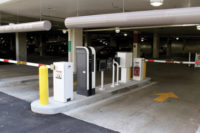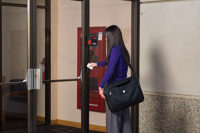There is no one-size-fits-all solution when it comes to parking and gate control. While there are some manufacturers that offer the complete package, it is far more common for a security integrator to have to pull together the disparate elements involved — from the physical barrier to the gate and motor, access control reader and intercom. And sometimes, this can get tricky.
Not surprisingly, trends across the security industry are also having an impact on parking installations, including wireless technology, IP, Voice over Internet Protocol (VoIP), more intelligence and portability and, most of all, the desire for convenience.
SDM assembled a virtual “panel” of industry insiders, each of whom provide different elements of a typical parking solution, and asked about the latest trends, products and advice. This panel included: Jack DeMao, CEO of electric security fence provider Electric Guard Dog LLC, Columbia, S.C.; Bennie Cooper, operations and senior technical engineer, Vingtor-Stentofon, Kansas City, Mo.; Greg Hamm, vice president, sales and marketing, Delta Scientific, Palmdale, Calif.; Paul Ahern, CEO, Cypress Integration Solutions, Lapeer, Mich., Scott Blue, director of marketing, perimeter access solutions, LiftMaster, Elmhurst, Ill.; and Brad Aikin, business leader, commercial electronic locks, Allegion, Carmel, Ind.
SDM: How do your solutions fit into an overall parking and gate control solution?
Blue:LiftMaster provides perimeter access systems for a variety of commercial gated properties as well as parking control applications. Along with the gate and barrier gate operators, we offer a range of access control products from wireless keypads to an Internet-enabled outdoor access control system with VoIP. LiftMaster’s products are frequently used as a package, as they are simple to install and are engineered to be compatible and perform reliably when paired together. It is common for integrators to pair our barrier gates, access controls and radio receivers together in parking applications.
Ahern: Cypress manufactures several devices used in parking and gate control. For example, our handheld card readers expedite credentialing at parking gates. Since the readers are wireless, security personnel can go directly to a driver or passenger to verify identification.
Hamm: Delta Scientific’s parking and gate control lines include motorized parking controllers, parking control gates, parking lot barricades, vehicle loop detectors and warning signs. Sometimes, vehicle access control is part of the overall enterprise systems designed by the dealer; other times, it is a project on its own. Delta has trained, experienced contractors around the globe. Because the installation of this equipment, which often includes digging holes, etc., is different than the typical work done by integrators, most sub-contract this job to one of these organizations. Other integrators become trained by Delta and will do the entire job, from digging, leveling, electrical and testing.
Cooper: Our audio devices can be found throughout a parking garage from the entrance/exit (gate control) to security/emergency call units located throughout a parking garage to offer assistance and emergency support when necessary. We provide an IP audio device that interfaces with CCTV and access control for a complete parking security system.
DeMao: We are a security integrator that specializes in electric security fences. Commercial entities that store valuable material outside are increasingly using Electric Guard Dog electric security fencing to reduce guard cost and improve security. For those that want full automation, we integrate access control using an electric gate, video, intercom and electric security fencing. We supply all the components to the system except for the electric gate motor itself (the customer usually already has this installed) and the internal phone line that the customer prefers.
Aikin: At Allegion our most popular solution is the networked real-time wireless reader interface (WRI).The WRI integrates with a broader access control system that an integrator will use, similar to a wireless integrated lock. When a credential for that parking gate is presented to a traditional card reader connected to the WRI, information is passed through the solution and communicated wirelessly to the host access control system.
SDM: How do the latest trends in communication such as wireless, smartphones and IP affect parking and gate installations?
DeMao: VoIP technology is decreasing in cost while simultaneously improving in reliability and quality. The product has proven to be a better solution than using customers’ plain old telephone (POTS) lines. Getting an additional POTS line from a large company is increasingly difficult and coordinating service calls with the telephone supplier is challenging. Providing our own VoIP service allows for speedier installation and higher quality results.
Hamm: Intelligent vehicle systems can check the velocity of an approaching vehicle or set off an alarm if a car is coming down the wrong lane. Intelligent vehicle systems also are able to tell if a vehicle is too large to enter a parking structure, potentially saving countless dollars on structural repairs.
Cooper: Currently in the U.S. we’re seeing an emergence in new parking technology that aids greatly in situational awareness. With this movement, we see IP technology helping lower the overall installation cost by connecting to any local IP network while greatly enhancing the quality of audio and video devices.
Ahern: There has been increased demand for both fixed and portable wireless as well as fiber optic interface solutions for quicker and more cost effective installations.
Blue: Utilizing VoIP technology and high speed Internet connection has made it simple to maintain by allowing property managers to work smarter and more efficiently as all data is transferred over the Internet. Additionally, updates can be made anywhere, at any time through the web-based software.
Aikin: I believe the most important advancement for gate and parking installations in the near future will be the increased adoption of mobile credentials, as well as the development of new hardware that simplifies the connectivity to parking applications with the use of additional wireless technologies.
SDM: What are the most common pitfalls dealers and integrators face in parking and gate installations?
DeMao: The key problem we see in automating access control and security is having to rely on or coordinate with other vendors of the customer. The customer’s phone lines may not be of sufficient quality for security and the electric gate operator may not be of sufficient reliability or quality. Since these other vendors have a business relationship with the customer, coordinating and diagnosing with them can be challenging. When possible it is best to provide as much of a turnkey situation as possible including VoIP.
Ahern: Our experience has shown that traditional security dealers and integrators are not prepared for the installation challenges involved with gate installations like concrete islands, protective bollards, vehicle detection loops and the distance limitations for low voltage power and communications like Wiegand.
Blue: Gate and parking installation can be very detailed and complex. This can make any job a challenge.
Aikin: When it comes to gate and parking installations, at times we see dealers and installers struggle to consider external environmental changes that take place at or around a parking gate throughout the full course of a calendar year. This could include weather, vehicle traffic, or new construction.
SDM: What specific advice would you give to integrators and dealers on how to have a successful gate or parking installation?
Cooper: Ask the end user their wants and needs. Have them provide you with a call scenario or theory of operation in detail. That will allow you to better understand what the end user needs and to provide the correct solution and equipment for the job. If this step is taken, the installation and equipment provided will result in a good installation and help to build a trusting relationship between the dealer and the end user.
DeMao: While the technology is important, the most critical factor is fully understanding the customer’s application. Gaining a good understanding of how the customer actually operates and how their employees will interface with the system is critical. Many customers believe that their operational practices are standard, and may not be sensitive to their variances.
Ahern: While there are exceptions, it can be challenging to combine security and parking projects. It should go without saying to do your homework, and expect the unexpected. Do not shortcut the site inspection process. Companies such as ours already offer solutions to some of these challenges and we are constantly creating custom solutions, but it’s optimal to think through the issues and contact us early in the process, rather than reacting when something goes wrong.
Hamm: Just as dealers and integrators need training on standard access control, alarms, video and the other technologies that make up a full security system, they need training on vehicle access control. In such training, they will learn how to specify the right equipment for any particular job. They will also learn how to create the most secure system. For instance, regardless of the type of vehicle control system installed, any entrance to a parking garage or lot must not provide a long ramp or driveway that lets a vehicle pick up speed before arriving at the access point. Forcing vehicles to slow down by creating an S curve just before the entrance automatically creates a more secure environment.
Aikin: I’d say that dealers and integrators need to utilize vendor information in the marketplace based on specific guidelines and recommendations they have on how to deploy technology. As integrators consult with their clients about parking gate applications, I would recommend they also be sure to ask about the traffic and environment around the parking areas to ensure these factors are included in the development of the proposed solution. Secondly, I’d say that dealers and integrators should take advantage of vendor information in the marketplace such as specific application guides, datasheets, and wiring diagrams.
SIDEBARS: Parking Products
SDM asked: What new products do you have and how will they help with parking and gate installations?
Brad Aikin (Allegion): We continuously are focusing on opportunities to enhance value and extend the application of electronic access control. Particularly with parking gates, convenience is critical. This includes the development of mobile credentials such as AptiQmobile, which allows a person to use their mobile phone to gain access. In addition, we also offer a wireless portable reader (WPR). This solution is similar to a traditional wall mount reader; however the reader is mounted to a portable wireless enclosure.
Scott Blue (LiftMaster): As the demand for secure systems increases, technologies that simplify the process are critical. LiftMaster’s new IPAC (Internet Protocol Access Control) is an Internet-enabled outdoor access control entry system with VoIP Technology. By harnessing the power of a high-speed Internet connection, IPAC allows you to work smarter and more efficiently as it transfers all data over the Internet. The web-based software provides instant access to your system from any browser, any device, anywhere.
Paul Ahern (Cypress Integration Solutions): There has been increased demand for both fixed and portable wireless as well as fiber optic solutions for quicker and more cost effective installations. Cypress is on the verge of releasing our new OSMIUM product line of middleware solutions with enhanced security, supervision and data reliability. We also have a lineup of products that include wireless, Ethernet, fiber optic and wired interfaces. These devices connect card readers, Automatic Vehicle IDentification (AVID) readers, remote gates and signs with most parking and gate control packages and solutions.
Greg Hamm (Delta Scientific): There is a growing concern among many parking lot managers to go green. The Delta HD300 barrier, available with either a fully electric or hydraulic control unit, will stop a 15,000 pound vehicle traveling 50 mph. But for those trying to minimize their carbon footprints, the HD300 is available with either an electro-mechanical or hydraulic power unit. The electro-mechanical version obviates the chances of potential leaks or spills from hydraulic units. However, the HD300’s hydraulic unit doesn’t need to use petroleum based oil; it will run on bio-degradable oils, usually derived from cooking oils. Either way, the customer application can be green.
Bennie Cooper (Vingtor-Stentofon): We see IP technology helping to lower overall installation cost by connecting to any local IP network while enhancing the quality of audio and video devices. Recently we introduced an audio kit to provide crystal clear audio at any location. It allows any parking integrator/installer to retrofit our device into an existing panel. Our IP audio offers “active noise cancellation” that cancels out loud background noise, ideal for a noisy parking garage. So, with the simple installation of a small audio device, any application can now have quality audio, regardless of the initial installation or location.









